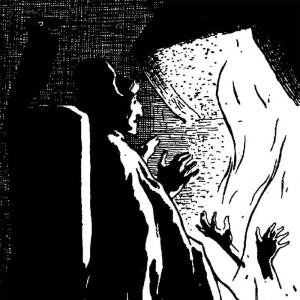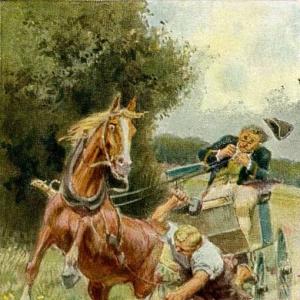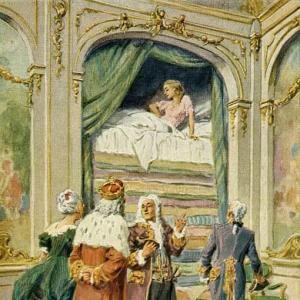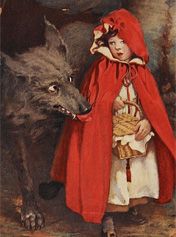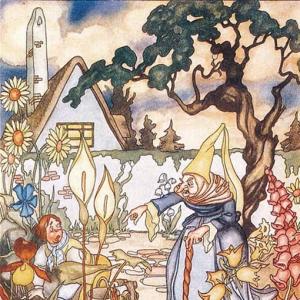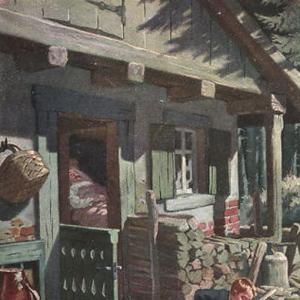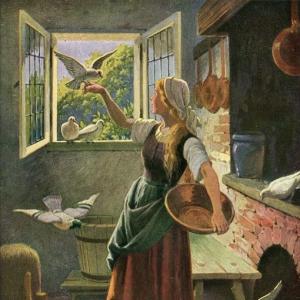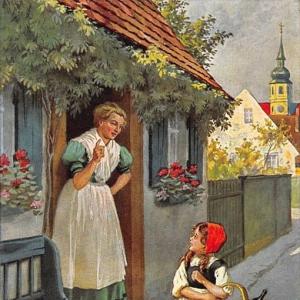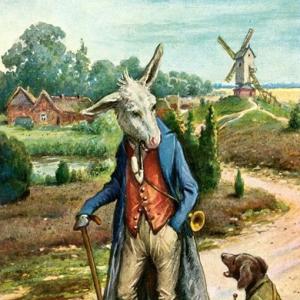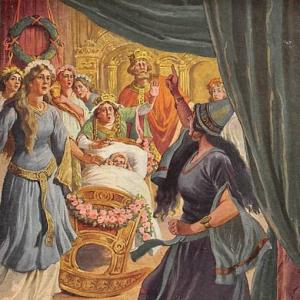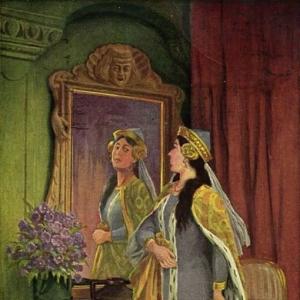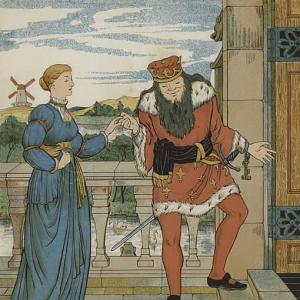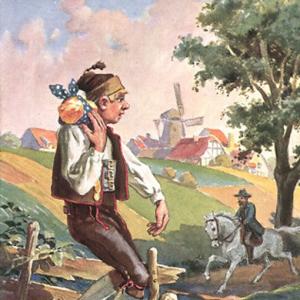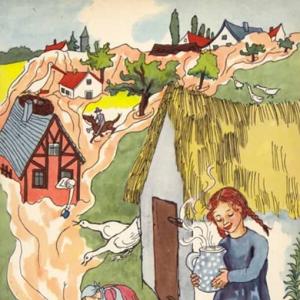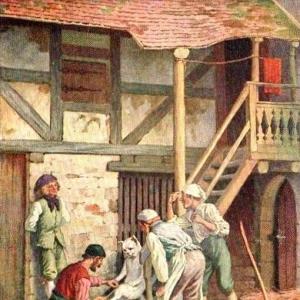Reading time: 6 min
The story we have for you here is really divided into two parts. The first part could be omitted, but it gives us some preliminary information which is useful.
We were staying at a manor house in the country, and it happened that the owner was absent for a day or so. Meanwhile a lady with a pug dog arrived from the next town; come, she explained, to dispose of the shares in her tannery. She had her certificates with her, and we advised her to seal them in an envelope and to write on it the address of the proprietor of the estate, „General War Commissary, Knight,“ etc.
She listened to us, took up the pen, then hesitated, and begged us to repeat the address slowly. We complied and she wrote, but in the middle of the „General War–“ she stopped, sighed, and said, „I’m only a woman!“ While she wrote, she had placed her Puggie on the floor, and he was growling, for the dog had come with her for pleasure and health’s sake, and a visitor shouldn’t be placed on the floor. He was characterized outwardly by a snub nose and a fleshy back.
„He doesn’t bite,“ said the woman. „He hasn’t any teeth. He’s like one of the family, faithful and grouchy; but the latter is the fault of my grandchildren for teasing him. They play wedding, and want to make him the bridesmaid, and that’s too strenuous for the poor old fellow.“
Then she delivered her certificates and took Puggie up in her arms. And that’s the first part of the story, which could have been omitted.
Puggie died! That’s the second part.
About a week later we arrived in the town and put up at the inn. Our windows looked out into the tannery yard, which was divided into two parts by a wooden fence. In one section were hides and skin caps, raw and tanned. Here was all the equipment for carrying on a tanning business, and it belonged to the widow. Puggie had died that morning and was to be buried in this section of the yard. The widow’s grandchildren (that is, the tanner’s widow’s, for Puggie had never married) covered the grave-a grave so beautiful it must have been quite pleasant to lie there.
The grave was bordered with broken flowerpots and strewn over with sand; at its head they had stuck up a small beer bottle with the neck upward, and that wasn’t at all symbolic.
The children danced around the grave, and then the oldest of the boys, a practical youngster of seven, proposed that there should be an exhibition of Puggie’s grave for everybody living in the street. The price of admission would be one trouser button. That was something every boy would be sure to have and which he also could give to the little girls. This suggestion was adopted by acclamation.
And all the children from the street, and even from the little lane behind, came, and each gave a button. Many were seen that afternoon going about with one suspender, but then they had seen Puggie’s grave, and that sight was worth it.
But outside the tannery yard, close to the entrance, stood a ragged little girl, very beautiful, with the prettiest curly hair, and eyes so clear and blue that it was a pleasure to look into them. She didn’t say a word, nor did she cry, but every time the gate was opened she looked into the yard as long as she could. She had no button, as she knew very well, so she had to stand sorrowfully outside, until all the others had seen the grave and everyone had left. Then she sat down, put her little brown hands before her eyes, and burst into tears, for she alone hadn’t seen Puggie’s grave. It was a heartache as great as any grown-up can experience.
We saw this from above-and seen from above, this, like many of our own and others‘ griefs could, made us smile! That’s the story, and anyone who doesn’t understand it can go and buy a share in the widow’s tannery.
 Learn languages. Double-tap on a word.Learn languages in context with Childstories.org and Deepl.com.
Learn languages. Double-tap on a word.Learn languages in context with Childstories.org and Deepl.com.Backgrounds
Interpretations
Adaptions
Summary
Linguistics
„Heartache“ is a lesser-known fairy tale written by Danish author Hans Christian Andersen. Andersen is a famous 19th-century writer best known for his timeless and enchanting fairy tales, such as „The Little Mermaid,“ „The Ugly Duckling,“ „The Emperor’s New Clothes,“ and „The Snow Queen.“ He was born on April 2, 1805, in Odense, Denmark, and died on August 4, 1875, in Copenhagen.
Andersen’s stories often focus on themes like love, loss, identity, and the human condition. They frequently feature elements of fantasy and folklore, and many of his tales have a moral or philosophical message. Andersen’s work has been translated into numerous languages and has inspired countless adaptations in various forms of media, including film, television, theater, and ballet.
Although „Heartache“ is not one of Andersen’s more famous stories, it shares some common themes with his other work, such as the exploration of childhood innocence, the nature of sorrow, and the importance of empathy. The story provides a glimpse into the everyday life of the 19th-century Danish society, including the roles of women, children, and social classes. It also showcases Andersen’s penchant for crafting simple yet profound narratives that capture the imagination and invite deeper reflection on universal human experiences.
There are several possible interpretations of Hans Christian Andersen’s „Heartache“:
Perspective on suffering and loss: The story highlights how heartache and grief can be experienced differently depending on one’s age, perspective, and circumstances. The little girl’s sorrow over not being able to see Puggie’s grave may seem trivial to an adult, but it is deeply felt by her. This suggests that it is essential to be empathetic and understanding towards others‘ pain, even if it appears insignificant from our point of view.
Childhood innocence: The children’s actions in the story, such as organizing an exhibition of Puggie’s grave and charging a trouser button for admission, demonstrate the innocence and creativity of childhood. The story reminds us of the simple pleasures and genuine emotions children experience, which can be forgotten or overlooked by adults.
Social inequality: The ragged little girl’s inability to pay the admission fee with a trouser button might be interpreted as a commentary on social inequality. While the other children can easily access the grave, she is left out due to her lack of resources. This highlights the disparities that can exist within society and the impact they can have on individuals.
Mourning and memory: The story also touches on the themes of mourning and memory. Puggie’s burial and the exhibition of his grave reflect the human need to remember and honor those who have passed away, even in the case of a pet. This can serve as a reminder of the importance of cherishing memories and honoring the lives of those who have left an impact on us.
The role of storytelling: Finally, the two-part structure of the story and the narrator’s acknowledgment that the first part could be omitted emphasize the role of storytelling itself. The first part provides context and sets up the events in the second part, but it also serves as an example of how stories can be shaped, altered, or embellished for effect. This interpretation invites readers to consider the power of storytelling and its ability to captivate, entertain, and convey deeper meanings.
Hans Christian Andersen’s fairy tale „Heartache“ has been adapted into various forms over the years, including:
Theater productions: „Heartache“ has been adapted into several stage productions, including a 2008 musical adaptation in Denmark titled „Hjertesorg – The Musical“.
Films: In 2013, a French short film adaptation of „Heartache“ titled „Le Coeur régulier“ was released, directed by Vanja d’Alcantara. The film reimagines the story as a contemporary drama about a woman who undergoes heart transplant surgery.
Children’s books: „Heartache“ has been adapted into several children’s books, including a 2017 picture book adaptation by Simon Kroug titled „The Heartless Troll“.
Operas: In 2011, composer Jacob TV adapted „Heartache“ into an opera titled „The News“, which premiered in the Netherlands.
Art installations: In 2016, artist duo Studio Drift created an art installation called „Heartache“, inspired by the fairy tale. The installation consisted of 18 mechanical flowers that opened and closed in response to the heartbeats of visitors.
Overall, „Heartache“ has proven to be a rich source of inspiration for artists across various mediums, demonstrating the enduring power of Andersen’s storytelling.
„Heartache“ by Hans Christian Andersen tells a story divided into two parts. In the first part, the narrator recounts their encounter with a lady and her pug dog, Puggie, at a manor house. The lady came to sell shares in her tannery and sought assistance in addressing an envelope to the estate’s proprietor. The narrator describes Puggie as a snub-nosed, fleshy-backed dog who is grouchy but faithful.
The second part of the story takes place a week later in a town where the narrator stays at an inn overlooking the tannery yard. Puggie has died, and the widow’s grandchildren have buried him in a beautiful grave in the yard. The children decide to hold an exhibition of Puggie’s grave, charging a trouser button for admission.
Many children from the street and the nearby lane come to see the grave, paying the price of a trouser button. However, a ragged little girl with beautiful curly hair and clear blue eyes cannot enter because she has no button. After everyone else has seen the grave and left, she sits down and cries, experiencing a heartache as great as any grown-up’s. The story concludes by noting that the girl’s grief, as well as many of our own sorrows, may seem trivial when viewed from above.
The fairy tale „Heartache“ by Hans Christian Andersen provides a poignant and multi-layered narrative that invites a deep linguistic and thematic analysis. This tale is structured in two parts, with the first providing contextual background and the second delivering the emotional core of the story.
Narrative Voice: The story is recounted in a conversational and reflective tone, possibly from the perspective of a visitor or observer. The use of first-person plural „we“ creates a sense of shared experience among the narrators and their audience, fostering a communal understanding of the events described.
Characterization: Andersen uses subtle character descriptions and dialogue to reveal deeper truths about the individuals. The lady with the pug is characterized by her hesitation in writing and her exclamation „I’m only a woman!“ which reflects the societal limitations placed on women at the time. Likewise, the characterization of Puggie serves as a metaphor for loyalty and familial bonds despite being trivialized through humorous descriptions.
Symbolism: Symbols are deftly woven into the narrative, many of which carry deeper implications. The grave, adorned with „broken flowerpots“ and a „small beer bottle,“ juxtaposes the solemnity of death with the innocence and simplicity of childhood interpretations of rituals. The choice of a „trouser button“ as the price of admission underscores themes of childhood poverty and innocence.
Irony and Humor: There is a gentle irony in juxtaposing the trivial, almost humorous details of Puggie’s funeral with the heartfelt sorrow experienced by the children. The narrators’ ability to smile at the little girl’s tears from a distance further emphasizes the irony of adult perspectives on childhood grief.
Emotional Contrast: Andersen contrasts the joyous play of children with the deep sorrow of the excluded little girl, capturing a spectrum of emotions. The heartache experienced by the girl is articulated with profound sensitivity, suggesting that childhood emotions are as significant as adult ones.
Thematic Analysis
Childhood Innocence and Grief: Andersen explores the depth of childhood emotions, particularly the sharpness of exclusion and the intensity of sorrow in a world that seems trivial to adults. The little girl’s heartache is not dismissed, emphasizing that children’s feelings are valid and deeply felt.
Social Class and Exclusion: The narrative subtly critiques social and economic disparities. The ragged little girl’s inability to participate highlights issues of poverty and exclusion, which resonate with broader social themes.
Mortality and Memory: Puggie’s death serves as a catalyst for exploring themes of mortality and the ways individuals, particularly children, commemorate and remember those they have lost. The children’s creative memorialization of Puggie springs from innocence yet grapples with the larger concept of death and loss.
Empathy and Perspective: The story invites readers to reflect on the nature of empathy and perspective. Observing the heartache from above instigates a conversation about how adults perceive childhood pain and the importance of validating it.
In sum, „Heartache“ is a rich narrative that combines humor, irony, and poignant emotion to probe deeply into themes of childhood, social dynamics, and the human response to loss. Through linguistic precision and stylistic choices, Andersen invites readers to not only empathize with the characters but also to reflect on broader human experiences.
Information for scientific analysis
Fairy tale statistics | Value |
|---|---|
| Translations | DE, DE, EN, DA, IT |
| Readability Index by Björnsson | 32.3 |
| Flesch-Reading-Ease Index | 73.7 |
| Flesch–Kincaid Grade-Level | 7.6 |
| Gunning Fog Index | 10.3 |
| Coleman–Liau Index | 8.9 |
| SMOG Index | 10 |
| Automated Readability Index | 7.7 |
| Character Count | 3.780 |
| Letter Count | 2.918 |
| Sentence Count | 37 |
| Word Count | 695 |
| Average Words per Sentence | 18,78 |
| Words with more than 6 letters | 94 |
| Percentage of long words | 13.5% |
| Number of Syllables | 937 |
| Average Syllables per Word | 1,35 |
| Words with three Syllables | 52 |
| Percentage Words with three Syllables | 7.5% |

 Facebook
Facebook  Whatsapp
Whatsapp  Messenger
Messenger  Telegram
Telegram Reddit
Reddit